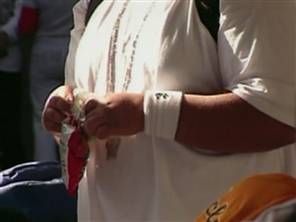
Image Credit: The Museum of Fat Love
H/T: Layne Craig
Amidst massive media coverage of the “obesity epidemic,”
visual arguments have emerged online that challenge the terms of the current
debate. One example is the
website, The Museum of Fat Love,
which presents a collection of photographs of smiling couples. Similarly, Newsweek ran a series of photographs on their website
titled “Happy, Heavy and Healthy”
in which readers submitted pictures of themselves performing athletic
feats. Both websites called for
volunteers to submit evidence that individuals classified as overweight or
obese can live healthy, happy lives.
The use of visuals in both instances is striking—both websites are
predicated on the understanding that overweight individuals have been misunderstood
(perhaps even vilified) in the course of public debates on obesity and public
health.
These photo collections led me to consider representations
of obesity in other media and, particularly, the cropped photographs that
feature so regularly on local nightly new programs. Why is it that obesity is so often represented by a headless
body? Although the obvious answer
is to protect the identity of these individuals, such images paint an
eerily dehumanized portrait of obesity.
The obesity debate has created a strange visual rhetoric that
photographic montages such as The Museum of Fat and “Happy, Heavy and Healthy”
may be attempting to reorient.

Image Credit: MSNBC
In a recent article in Slate Magazine, "Glutton Intolerance," Daniel Engber argues that social stigmas against overweight individuals are not only deplorable but
may actually cause the health problems associated with obesity. Citing a study by epidemiologist Peter
Muennig,
Engber writes that weight discrimination contributes to the
stress-related illnesses that are generally attributed to obesity. If weight-stigma is itself a public
health “epidemic” then perhaps visual evidence for active, well-loved plus-size
people may perform an important function in undermining stigmas and, thereby,
relieving dangerous stress.
Comments
Faces!
I think it's notable that all of these images include not just smiles, but faces! Recent spoofs on the Daily Show and an article on CharlotteCooper.net's "Fat" page highlight the ubiquitous headless obese person in news stories. What's the visual appeal of headlessness? What would the implications of including people's faces be? What assumptions are going into those shots? I think a lot of mainstream people, including media producers, assume that overweight people must be unhappy. But I have great respect for the fat activism occurring in visual media and elsewhere.
Thanks!
Great post! I was found it fascinating how many folks posted the Newsweek photos to their Facebook page; they really seemed to resonate.